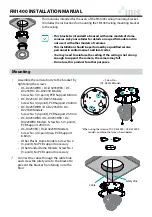
10
INFORMATION FOR PRIVATE HOUSEHOLDS
1. Separate collection of waste equipment: Electrical and electronic equipment that has become waste is referred to as waste
equipment. Owners of waste equipment must dispose of it separately from unsorted municipal waste. In particular, waste
equipment does not belong in household waste, but in special collection and return systems.
2. Batteries and rechargeable batteries as well as lamps: Owners of waste equipment shall, as a rule, separate waste batteries and
rechargeable batteries that are not enclosed in the waste equipment, which can be removed from the waste equipment without
being destroyed, from the waste equipment before handing them in at a collection point. This does not apply if waste equipment
is prepared for reuse with the participation of a public waste management authority.
3. Options for returning waste equipment: Owners of waste equipment from private households can return it free of charge to the
collection points of the public waste management authorities or to the take-back points set up by manufacturers or distributors
within the meaning of the Electrical and Electronics Equipment Law. Stores with a sales area of at least 400 m² for electrical
and electronic equipment and those grocery stores with a total sales area of at least 800 m² that offer electrical and electronic
equipment several times a year or on a permanent basis and make it available in the market are required to take it back. This also
applies in the case of distribution using means of distance communication, if the storage and shipping areas for electrical and
electronic equipment are at least 400 m² or the total storage and shipping areas are at least 800 m². Distributors shall, in principle,
ensure take-back by providing suitable return facilities at a reasonable distance from the respective end user. The possibility of
returning waste equipment free of charge exists for distributors who are obliged to take it back, among other things, if a new
similar device that essentially fulfills the same functions is delivered to an end user.
4. Privacy Notice: Waste equipment often contains sensitive personal data. This applies in particular to devices of information
and telecommunications technology such as computers and smartphones. In your own interest, please note that each end user is
responsible for deleting the data on the waste equipment to be disposed of.
5. Meaning of the symbol “crossed-out wheelie bin”: The symbol of a crossed-out wheelie bin regularly depicted on electrical and
electronic equipment indicates that the respective device is to be collected separately from unsorted municipal waste at the end
of its service life.






























